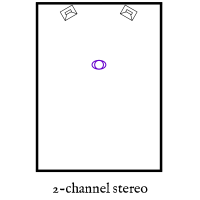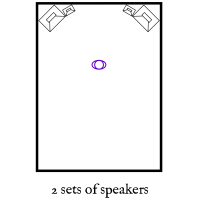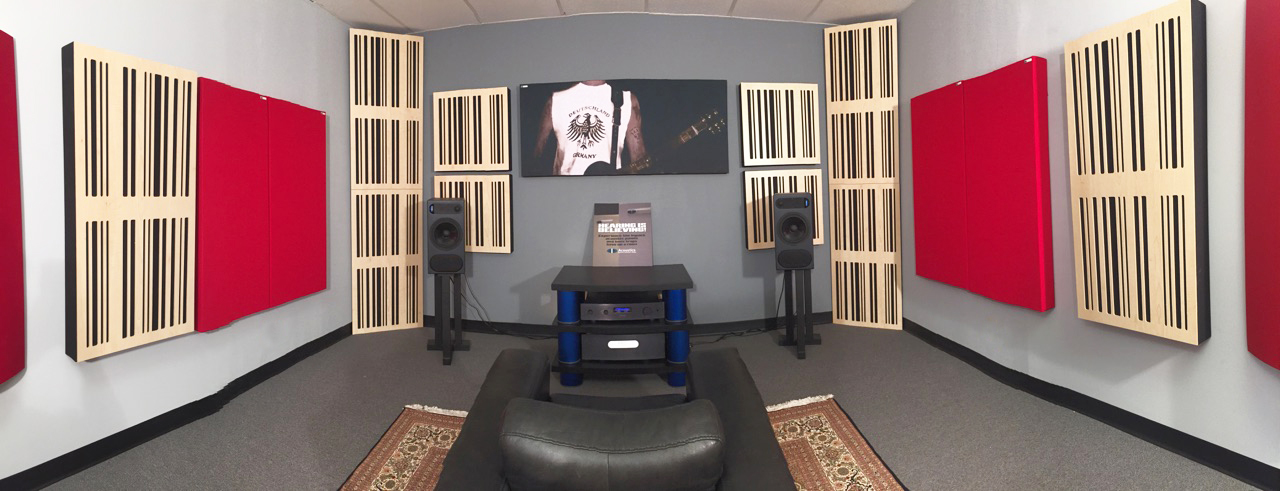Speaker placement seems as much art as science. A lot of ink has been spilled covering the countless speaker placement strategies being used and favored in the audiophile and pro audio communities. As such, there is already an excellent selection of resources on GIK’s website about room setup and speaker placement, but this is an interesting enough topic that I wanted to dig a little more deeply into some of my favorite speaker placement strategies in the face of the two main problems we must consider for quality sound reproduction.
Two competing problems
Since the introduction of stereophonic playback systems, one of the main concerns with good speaker placement is stereo imaging, or soundstaging. Different people will use these terms differently, and there is a lot of overlap between the two ideas. The essence of it is that a high-quality stereo playback system can convey astounding realism, with sonic depth, width, and height, creating a sonic space for a vivid listening experience.
The other primary problem with speaker placement is getting an accurate bass response, which is always a challenge in the small rooms most of us are working with. Reflected bass waves interact with one another, combining together and producing the peaks and nulls associated with comb filtering, along with the more general modal and SBIR issues in the room.
Before we dive deeper into these two factors with speaker placement, I want you to notice something: These problems with speaker placement, bass trapping and quality stereo imaging, are also the exact same two problems we prioritize in our acoustic treatment strategies. Therefore, it’s important to remember that treatments work together with placement inside the room to help maximize the sound potential of the audio system. Let’s take a closer look at these two factors.
Soundstage & Imaging
“Everyone who has been fortunate enough to hear [stereophonic sound] has remarked that … the sound takes a special character of relief and localization which [monophonic sound] cannot produce…. The singers place themselves, in the mind of the listener, at a fixed distance, some to the right and others to the left. It is easy to follow their movements, and to indicate exactly, each time that they change their position, the imaginary distance at which they appear to be. This phenomenon is very curious… and has never been applied, we believe, before to produce this remarkable illusion.”
— Clément Ader, “The Telephone At The Paris Opera,” Scientific American, December 31, 1881.
I find it interesting that these first people to experience stereophonic sound reproduction in 1881 heard it via headphones, or more accurately, by holding a pair of old-school telephone “cups” up to their ears. To this day, listening with headphones can provide a vivid soundstage leading to a great listening experience. But I think few would argue that listening with a great set of speakers in a great room has a higher ceiling for quality sound reproduction and a superior listening experience.
But unlike listening with headphones, in which the speakers are fixed relative to the listener’s ears and the only acoustics at play are with the headphone drivers and the ear canal, using speakers in a room requires some thought and planning to get the best results, particularly in terms of the soundstage.
 The basic starting point for setting up speakers is to put the two speakers into an equilateral triangle with the listening position, or the point in the room where the listener’s head resides while listening. There are many variations on this theme. Some prefer to make the focal point of the driver slightly behind the listening position. Others prefer to have the speakers wider, with a 45-45-90 isosceles triangle rather than the 60-60-60 equilateral triangle. Some prefer to “toe” the speakers in, so they are facing directly toward the listener. Others prefer to leave them pointing straight toward the rear of the room. And, different speaker manufacturers will have different recommendations for using their products, one common variable being how far from the front wall the speakers should be for optimal imaging.
The basic starting point for setting up speakers is to put the two speakers into an equilateral triangle with the listening position, or the point in the room where the listener’s head resides while listening. There are many variations on this theme. Some prefer to make the focal point of the driver slightly behind the listening position. Others prefer to have the speakers wider, with a 45-45-90 isosceles triangle rather than the 60-60-60 equilateral triangle. Some prefer to “toe” the speakers in, so they are facing directly toward the listener. Others prefer to leave them pointing straight toward the rear of the room. And, different speaker manufacturers will have different recommendations for using their products, one common variable being how far from the front wall the speakers should be for optimal imaging.
For most speakers in a small room, unless they send out high frequencies from the rear of the speaker, placing the speakers as close to the front wall as possible gives the best results. Taking a simple rectangular room allows us to illustrate these strategies as shown here.
Note a few characteristics of the room:
-
The listening position is approximately 3/8 of the length of the room (38%)
-
The speakers are in a 60-60-60 equilateral triangle with the listener’s head
-
The speakers are approximately ¼ the room width away from the corners. Keep this in mind; the importance of this will be explained in Part 2 of this article when we discuss multiple subwoofers.
 Sometimes, particularly in project studios or listening rooms, there will be two sets of speakers to deal with, commonly a larger set of studio monitors capable of deep bass, and a smaller set of lower-fi monitors to represent a more “realistic” playback system most users will have in their homes. One setup possibility is shown here, with the smaller speakers in a 60-60-60 equilateral triangle setup, and the larger speakers in a 45-45-90 configuration, which can sometimes give a wider soundstage.
Sometimes, particularly in project studios or listening rooms, there will be two sets of speakers to deal with, commonly a larger set of studio monitors capable of deep bass, and a smaller set of lower-fi monitors to represent a more “realistic” playback system most users will have in their homes. One setup possibility is shown here, with the smaller speakers in a 60-60-60 equilateral triangle setup, and the larger speakers in a 45-45-90 configuration, which can sometimes give a wider soundstage.
There are a few interesting things about this setup for a room this size and shape. Like the above room, the smaller speakers are set at about the 1/4 way point, and the larger speakers are directly in the corners. These placements are deliberate and will have consequences in the low end, not just in the imagine, which will be explained in part 2.
At the end of the day, the only way to know which setup works best for you, with your equipment, in your room, is to experiment. And of course, improving the quality of the soundstage is one of the key acoustic treatment strategies, usually enacted by placing thick absorbers at all nearby reflection points.
Bass, Room Modes, SBIR, and More
The other problem is that every room has a bass personality, and it imposes that personality on every sound in the room. There are many variables as to what this “bass personality” consists of, mostly having to do with simple geometry. The size and shape of the room are factors, as each dimension in a rectangular room will have various room modes associated with those dimensions. SBIR is also a problem, which is related to the distance between a speaker and a nearby boundary, usually the front wall or side walls. To combat SBIR, we typically want the speakers to be either less than a foot away, or more than three feet away, from any wall.
These are only two (modes & SBIR) of the many low frequency issues that will be in every room. Excess bass waves moving around the room interfering with one another will cause a wide variety of peaks and nulls at different frequencies in the room. This final response isn’t always predictable in terms of modes or SBIR; I’ve been surprised and puzzled by problems at measured frequencies that don’t seem to correspond to mode or SBIR calculations.
Again, experimentation in your room makes the most sense, especially if your room is less predictable (ie, it’s not a simple rectangular room).
The Art Of Compromise: Subwoofers
For conventional, full-range speakers, we must compromise between these two factors. Since all the drivers are in the same cabinet, putting them in the place for optimal imaging may not be the best place for accurate bass. In this case, speaker placement is almost always a compromise between these two competing problems.
One solution here is to use a system with subwoofers, so we can place the bass units where they give best results, and the satellites where they provide optimal imaging. In subwoofer/satellite systems, placement is very, very important. If placement is bad, then it’s quite difficult to get good sound from such a system. But if placement is optimized, you can get very very good results, optimizing both factors together without a compromise between the two. And, using multiple subwoofers can take it even further.
In Part 2 of this article, we’ll continue this conversation and explore various subwoofer placement strategies.
When In Doubt, Ask For Help
As always, we are happy to help you strategize about how to get the most out of your speakers with good placement strategies and patented GIK Acoustics treatments. Contact us for free acoustical advice.
 James Lindenschmidt is GIK Acoustics’ resident audiogeek. He records music, designs studios & listening rooms, and consults with clients to make better audio. He also writes and makes mead, at least until the revolution comes.
James Lindenschmidt is GIK Acoustics’ resident audiogeek. He records music, designs studios & listening rooms, and consults with clients to make better audio. He also writes and makes mead, at least until the revolution comes.






GIK Giveaway Viral Video Contest 2024
Room EQ Wizard TUTORIAL
How to set up and use REW In this video we show you how [...]
DIFFUSION Concepts Explained
How Acoustic Diffusers Work And Which One Is Right For You In this video [...]
Jan
The GIK Acoustic Advice
Get Your Room Sound Right For FREE! In this video we are giving a [...]
Jan
Designer Tips: The Significance of “Clouds” with Mike Major
When people reach out to us at GIK for acoustic advice, we never have any [...]
Jun
Designer Tips: The Importance of Coverage Area with James Lindenschmidt
The most important factor in acoustic treatment performance is coverage area. Or more specifically, the [...]
May
Designer Tips: Home Theaters and Acoustic Balance with John Dykstra
Without fail, one of the first things our clients say to us when we begin [...]
May
Summer Giveaway 2021 Vote
The GIK Acoustics Summer Giveaway Photo Contest 2021 invited customers to submit photos illustrating how [...]
Aug